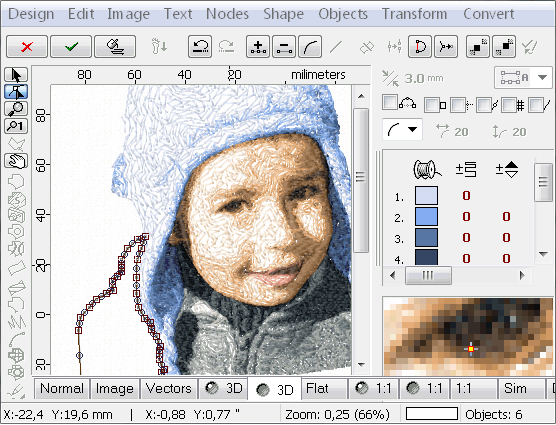Best Digitizing for Embroidery: Boost Your Tasks
Best Digitizing for Embroidery: Boost Your Tasks
Blog Article
Grasping the Embroidery Digitizing Refine: Your Ultimate Overview
Needlework digitizing is a thorough craft that calls for precision and experience to translate complex styles right into electronic formats for machine embroidery. As artisans begin on this trip to understand the embroidery digitizing procedure, an extensive understanding of the basics establishes the foundation for excellence.

Understanding Embroidery Digitizing Fundamentals
Needlework digitizing basics create the foundation upon which complex layouts are equated right into machine-readable styles for specific stitching. This preliminary action in the needlework digitizing procedure is critical for ensuring that the final embroidered product is a loyal depiction of the initial design. Understanding needlework digitizing basics involves grasping key ideas such as stitch kinds, stitch direction, density, underlay, and draw settlement.
Sew kinds play a crucial function in figuring out the visual and textural outcome of the embroidered layout. By choosing the proper stitch type, whether it be satin, fill, or running stitch, digitizers can accomplish the desired effect and enhance the total top quality of the needlework. Furthermore, sew direction influences the flow and measurement of the design, while thickness establishes the spacing and insurance coverage of the stitches.
Additionally, underlay sewing offers stability to the layout by protecting the textile and protecting against distortion during the embroidery procedure. Pull payment is one more vital consideration to neutralize the natural propensity of material to agreement when stitched. Mastering these embroidery digitizing essentials is essential for creating professional-quality stitched items.
Choosing the Right Digitizing Software Application
Picking the appropriate digitizing software program is an important decision that significantly influences the effectiveness and quality of the needlework digitizing process. Digitizing for Embroidery. When picking the best digitizing software, it is vital to consider factors such as the intricacy of styles you intend to develop, the user-friendliness of the software, the degree of client support used, and the compatibility with your needlework equipment
There are numerous digitizing software choices readily available in the marketplace, ranging from basic programs for beginners to advanced software for professional digitizers. Some popular choices include Wilcom EmbroideryStudio, Hatch Embroidery Software, and PulseID. These software provide a vast array of devices and attributes to aid you develop detailed layouts easily.
Prior to making a choice, it is recommended go to website to explore the different software choices through cost-free tests or demonstrations to establish which one finest fits your requirements. In addition, reading reviews and looking for referrals from knowledgeable digitizers can provide important understandings right into the toughness and weak points of each software (Digitizing for Embroidery). By carefully reviewing your requirements and contrasting the functions of various digitizing software application, you can make an educated choice that boosts your embroidery digitizing workflow
Digitizing Devices and Techniques

Optimizing Design Settings for Needlework
Mastering the intricacies of design setups is basic in attaining optimum outcomes in the needlework digitizing procedure, structure upon the foundation you can check here laid by comprehending digitizing devices and methods. When enhancing style settings for embroidery, it is necessary to think about elements such as stitch type, density, underlay, pull compensation, and enrollment. Sew kind choice affects the general look of the design, with options like satin, fill, and running stitches offering various structures and impacts. Density describes the spacing and density of stitches, impacting the design's protection and toughness. Correct rug stitching provides stability and avoids fabric distortion, particularly for complicated styles or on elastic products. Draw compensation changes for textile stretch during sewing, making certain precise design duplication. Registration setups align various aspects of the layout precisely, maintaining general design stability. By fine-tuning these design setups, embroiderers can enhance the high quality and precision of their stitched developments.

Troubleshooting Common Digitizing Issues
When encountering typical digitizing issues during the needlework process, it is important to understand the origin and execute reliable services without delay. One common trouble is stitch density problems, where stitches might be too thick, causing the material to tighten, or as well thin, resulting in voids in the visit this site right here style. Readjusting the stitch density setups in the digitizing software can assist resolve this concern.
Another regular obstacle is thread breaks throughout the embroidery process. This can occur as a result of various factors such as incorrect stress setups, dull needles, or utilizing low-grade thread. Making sure correct maintenance of the embroidery machine, consisting of regular needle modifications and stress changes, can decrease the occurrence of thread breaks.
In addition, design registration errors can lead to misaligned components within the needlework layout. Checking the design alignment in the digitizing software and making required modifications prior to sewing can assist in preventing this problem. By attending to these typical digitizing problems immediately and successfully, you can make certain a smoother needlework procedure and top quality completed products.
Conclusion
To conclude, mastering the needlework digitizing procedure calls for a solid understanding of the basics, the right choice of software, and knowledge of devices and strategies. Maximizing style settings and troubleshooting typical digitizing problems are important steps in ensuring high-quality needlework outcomes. By complying with these steps faithfully, one can attain accuracy and effectiveness in the digitizing process.
Report this page